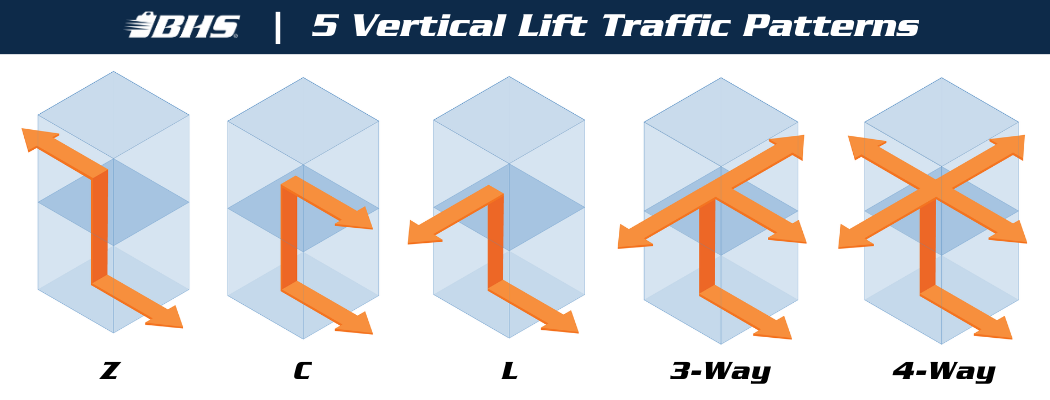We use cookies to make your experience better. To comply with the new e-Privacy directive, we need to ask for your consent to set the cookies. Learn more.
Vertical Lift Traffic Patterns: Planning for VRC Material Flow
 |
Vertical Reciprocating Conveyors (VRC) are efficient, safe, and affordable vertical lifts designed to move materials between levels. They’re essential for many multi-story warehouses, mezzanine-equipped manufacturing floors, and automated conveyor systems that use both vertical and horizontal space.
However, every facility is a little bit different. You may need to move pallet loads from ground-level to an upper story — but will you load and unload your VRC from the same side? Or will your upstairs forklift approach from the opposite edge, or even the left or right? Do these traffic patterns change from load to load?
These questions hint at a key design consideration for any custom VRC: vertical lift traffic patterns. Loading/unloading access to your VRC is based on at least three considerations:
- Your daily requirements for material flow
- The layout of your facility
- The technical capacity of your elevator shaft or other VRC installation footprint
Luckily, BHS, Inc. designs and builds every VRC to integrate with existing facilities, offering multiple access configurations to match. Here are the five most common material flow patterns supported by BHS VRCs, one of which is sure to fit your unique use case.
Learn more about Vertical Reciprocating Conveyors from BHS, Inc.
5 Traffic Patterns for VRC Vertical Lifts
As we explain in our VRC Buyer’s Guide , BHS supports four general types of custom VRCs:
- Straddle design, which place the carriage between two vertical guide beams
- Cantilever design, which support a carriage on a single-side lift track
- Four-post design, in which a carriage moves within four guide beams
- Double-mast design, in which the carriage sits cantilevered between two opposite sets of double masts
Each of these designs supports different combinations of traffic patterns. We’ll explain which design matches each of these common traffic patterns below:

1. The Z Pattern
Z-pattern material flow allows you to load a VRC from one side, then unload it from the opposite. Horizontally, your load moves in a straight line; the VRC simply enables you to transport materials up and down.
This is an ideal design for many mezzanines. With a straddle or four-post VRC installed at the outer edge of your mezzanine, you can load a pallet — or an automated guided vehicle, or virtually any other freight or equipment within capacity — from the front of the carriage at ground level. Once the load reaches the mezzanine, you unload it from the back.
2. The C Pattern
A C-pattern VRC provides loading and unloading access from the same side. It functions much like a single-door freight elevator (but without the cost and complexity of personnel-transporting vertical lifts).
All types of VRCs (straddle, cantilever, four-post, and double-mast) support C-pattern access. This traffic pattern is common in retrofits, where you install a VRC in an existing elevator shaft originally designed for single-door carriages.
3. The L (or 90-Degree) Pattern
If you load an L-pattern VRC from the front, the L-pattern configuration allows you to unload it from either the left or the right (and vice versa). In other words, you have access from the two end points of a 90-degree angle.
The L pattern is a relatively rare requirement, but it’s essential for certain material flow paths, especially in automated material handling systems. The placement of guide beams limits the type of VRC that supports L-pattern traffic to cantilever and four post designs.
4. The 3-Way Pattern
One or two angles of approach may not be enough, especially in busy distribution centers and warehouses. The 3-way traffic pattern offers more flexibility than either the L or C traffic flows. This design offers three carriage-access locations: the front, left, and right sides.
The good news is that all four types of VRC can be configured for 3-way traffic. This approach gives you a lot of flexibility in designing your material handling system, offering simple integration with facility-wide material flow infrastructure.
5. The 4-Way Pattern
For the most flexibility in VRC-carriage access, choose a vertical lift that supports 4-way traffic. The VRC carriage is a square or rectangle; the 4-way pattern makes all four edges open for access, whether you’re moving pallet loads via forklift or sliding parcels onto automated conveyor lines.
However, this four-way access limits the placement of guide beams. Only cantilever and four-post VRCs are able to offer this traffic pattern.
So which of these vertical-lift traffic patterns is right for your facility? The custom engineering team at BHS, Inc. can help you decide — but first, we need to know a little more about your project. Tell us about your facility through our custom manufacturing request form, or simply call our sales team at 1.800.BHS.9500 to start the conversation.
